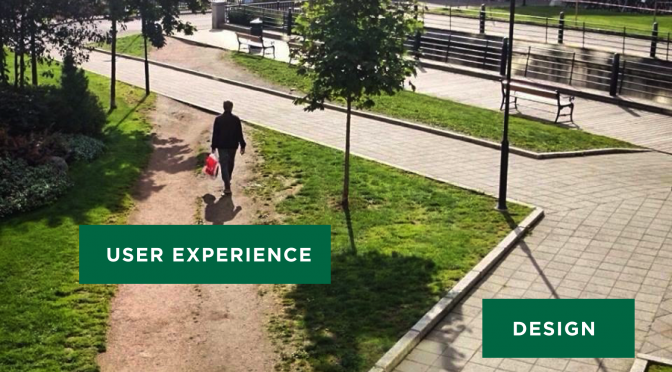I have seen this image and similar ones show up numerous times on a variety of my social media feeds and every time I see it I think, “hmm is that really a user experience or usability issue or is it just a fundamental design issue?“
I am not sure that an inappropriate design or a design that gets countermanded or circumvented by user behaviour has anything to do with user experience at all, but I may be wrong.
A colleague posted something similar to this some months back but in that instance he cited the examples of a speed bump that people would drive around to avoid.
Perhaps it isn’t a usability design flaw
While no one would disagree about the design flaw in the illustration, the design flaw is the fact that we cannot see how much the pathway is used versus the shortcut.
A well-designed pathway would support the corner cut and of course many of us would be able to find examples of cut corners in many things that we see and do every day.
No Jay Walking
Intelligent and considered design incorporates shortcuts, time-saving measures and mechanisms that support using less effort to achieve the same end result.
As systems and solutions evolve, we will likely see an increasing number of time and effort saving measures incorporated into products.
New solutions with a new user experience support this attempt to simplify and reduce complexity however in any reengineering effort there is one aspect that is inescapable. The aspect of control.
Keeping jays from walking
In big cities jaywalking is a pretty pervasive problem, so much so, that it is actually an offence for which you can be charged in some places with a stiff fine or citation. In the most literal sense, it is ‘crossing or walking in the street or road unlawfully’. Disallowing jaywalkers is ostensibly an attempt to manage pedestrians in such a way that drivers don’t have to keep stopping for pedestrians.
Jaywalkers can impair the flow of traffic and in fact, cause accidents between vehicles. According to the Oxford English Dictionary it first became popularized around 1917 but Peter Norton’s book on Fighting Traffic suggests that in the early 20th century, a “jay” was a pejorative term for a simple-minded rural resident somewhat unintelligent or naïve to live in the city. Such a person would not know to keep out of the way of speeding motorised traffic
Either way, if you didn’t want people to cross the road randomly, you either punish[ed] them or prevented them with things like railings, barricades and the like. On one of my many trips to India I have noticed that the central divider has an impassable railing fence to prevent pedestrians from passing over the dual lane carriageway. In some locales, the same is achieved with a K-Rail or “Jersey” Barrier.
At Wimbledon, to prevent people from falling into the roadway at busy times the AELTC has temporary railings installed and to ensure that there is no queue jumping airports and banks and music events, make use of fencing to corral and then train crowds into following a particular path.
All of these measures, the active (barriers) and the passive (regulations) perform two basic functions – they lead to somewhat predictable outcomes and try to control behaviour.
None of these systems design sets out to deliberately confound the user or participant, but similarly, no system is deliberately designed to have so many controls and management mechanisms in place that it accounts for every possible combination and permutation of behaviour. System designers have to strike a balance between usability and functional appropriateness.
Returning to the embedded illustration, when the renewal for the paths comes around in say twenty or so years, it is likely that the pathways will be rethought, that the corner cut will be incorporated however to do this today and right now would likely be not only disruptive but also expensive. Consider too, that this is something that maybe has not been planned or budgeted for.
In the ownership of complex systems this is the ongoing challenge.
Companies that produce and use complex systems will continue to try to strike that balance between form, function and usability but customers and users will have to be flexible in their thinking and requirements and understand that sometimes the reason that they cannot do certain things is not because of design deficiencies but perhaps because of the functional requirements evolving or because of the desperate need to maintain control and constraint.



